“…here is a story worth telling”

![]() n front of the temple, a sacred lire—called dhunl or “smoky” and associated
n front of the temple, a sacred lire—called dhunl or “smoky” and associated
with yogic ascetics—smolders in a pit of whitewashed cow dung, before which
is planted the trident emblem of Shiva. Just beyond, in the main shrine, an
egg-shaped stone lingam, attended by small murtis of Ganesha and Nandi,
receives a continuous oblation of cooling water dripping from a perforated
copper vessel. There are other deities in the room as well—Durga, the divine
trio of Rama-Sita-Lakshmana, and the eternal lovers Radha and Krishna—but
the principal items of veneration are a wooden bedstead covered with a coarse
blanket, and a large murti of a flying and beatifically smiling Hanuman,
rendered in highly polished white marble, which appears to float above the
main altar. On this special day, both Hanuman and the bedstead are canopied
with chains of brilliant orange and yellow marigolds. Lamps flicker on the
altars amid clouds of incense smoke, and the air seems electric with excitement.
The small room is crammed with worshipers, and many others who
cannot fit in stand at the low windows that open on three sides.
It is mid-morning, and the assembled devotees are halfway through a marathon 108
recitations of the Hanuman Chalisa, which they began at 4 am and will continue
until about 1 in the afternoon. Led by a succession of singers and accompanied
by harmonium, drums, and finger cymbals, the unison chanting uses a
variety of melodies and is sometimes rapid, sometimes slow, but always fervent,
and more so as the morning proceeds.
Meanwhile, in a nearby kitchen, devotees assemble huge platters of
sweets to be offered to Hanuman and distributed to worshipers at the end of
the chanting. Outside, cooks working over wood fires stir enormous cauldrons
of spiced chickpeas and potatoes, while others fry thousands of puris, for a
feast to be served in midafternoon to some eight hundred pilgrims, seated on
the ground in neat rows under a canopy. The feast will be followed by a local
production of the Ramayana, with homemade sets and costumes, enacted by
a handful of adults and numerous children, the latter especially in the roles
of monkey and demon “extras.” This production is already in rehearsal, and
actors in glittering crowns and face paint join devotees lining up for chai,
which is continually dispensed from a huge pot in the temple garden. Everywhere
there is bustling activity, yet without apparent central direction. The
morning air is crisp, for it is late September, and the temple stands on a high
plateau bordered by rugged mountains, visible in the distance in the golden
light.
The scene just described might be unfolding in the Himalayan foothills,
but for a few visual details that I have neglected to mention: the fact that
Hanuman’s flat-roofed temple is built of adobe and rounded beams, is down
the street from a shrine to the Virgin of Guadalupe, and is entered through a
parking area full of American and Japanese cars and pickups. It is, in fact, in
Taos, New Mexico, only a five-minute walk from the historic plaza with its
boutiques full of Navajo jewelry and cowboy apparel. Moreover, although the
devoted participants include a small number of U.S.resident, South Asians,
the majority, even among the fervent chanters of the Chalisa, are Americans of
Anglo-European ancestry. How they, and Hanuman, have come to be here is
a story worth telling, for it reveals a further facet of the ongoing—and
outgoing—appeal of this god.
From: Hanuman’s Tale, The Messages of a Divine Monkey – Philip Lutgendorf
A History of the Neem Karoli Baba
Ashram
in Taos, New Mexico
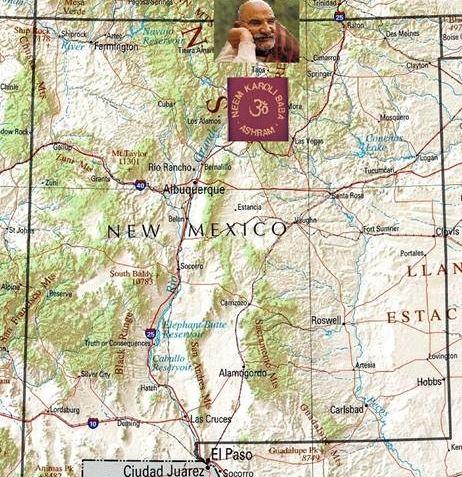
From Milk Barn to Temple
Ed Reither
The Vision
After Neem Karoli Baba’s (Maharajji) Mahasamadhi
Entering Great Samadhi upon death) in 1973, His
American devotees longed for a place to meet and share
stories, hold bhandaras (holiday feasts), sing kirtan
(devotional chants), and enjoy Satsang (the community of
those on the path together).

Neem Karoli Baba with Dada [Sudhir
Mukerjee] and Western devotees
In the spring of 1977, a group of thirty or forty
devotees gathered in Yorktown Heights, New York for a
Bhandara.

Yorktown Heights, 1977
During the gathering, Ram Dass proposed that a painting,
by Lakshmi (Christine Tiernan) an American devotee of
Maharajji, should be made into a murti statue and be placed
in a future temple in America. The painting depicted Hanuman
flying towards Lanka in search of Sita, carrying Rams
ring in his hand, a token demonstrating to Sita that Hanuman
– who was otherwise unknown to her – was indeed Ram’s true
messanger as well a symbol of hope and reunion, of love in
motion.

Lakshmi’s Painting

Sita Temple, Sri Lanka – Yellow markings are the
footprints of Hanuman landing
The project was funded by Ram Dass through the Hanuman
Foundation. A highly respected sculpture shop
in Jaipur, owned by the same family of sculptors who carved
the murti of Hanuman in Maharajjis Vrindaban
ashram was commissioned to do the work.
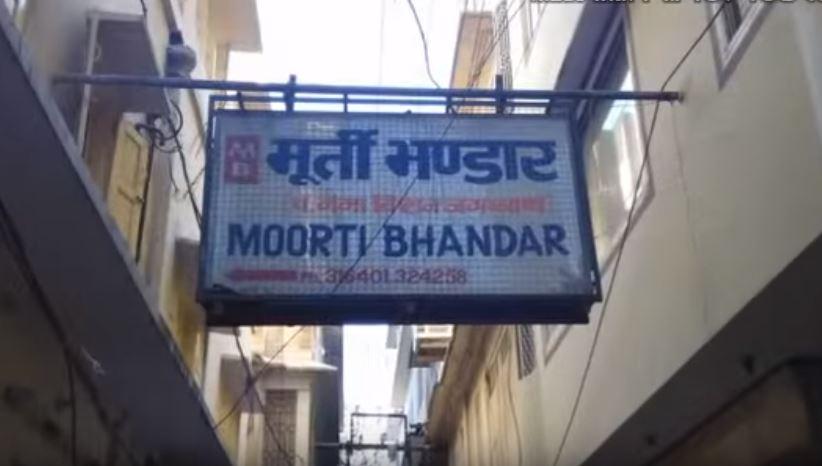
Moorti Bhandar, Jaipur
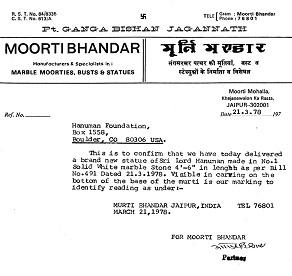
The early-on American devotees who were with Neem Karoli
Baba in India had been introduced to Hanuman thanks to Baba’s
building of Hanuman Temples. Maharajji loved the Ramayana.
He particularly liked the chapter “Sundarakand.” and liked
the widely read Hindi language version composed by Tulsi Das.
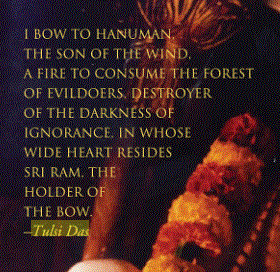
Public recitation of the entire chapter, intoned in verse over loudspeakers, was regularly heard at his ashrams. Sundarakand, literally “beautiful episode/book,” is the fifth book in the Hindu epic of the Ramayana. It depicts the adventures of Hanuman. Sundarakand is the only chapter in which the focal character is not Rama, but Hanuman. Hanuman’s selflessness, strength, and devotion to Rama are emphasized in the text. Hanuman was fondly called Sundara by his mother Anjani, and Sage Valmiki chose this name for the chapter because it deals mainly with Hanuman’s journey to Lanka.
Maharaji and Hanuman
How close to Hanuman Maharajji is, is known only to the two of them. There are stories by devotees who have shared what Maharajji has said about it. A pundit from Unnao who came to the temple to read to him from Sundarakand, “What part should I read Maharajji?” the pundit asked. “Read the part when I meet Vibishan,” Maharajji replied. Dada [Sudhir Mukerjee] describes the moment; he said, “a chill ran through those who were present.” There are other stories of Maharajji turning into Hanuman, one of which you can read in Dada’s book, ‘By His Grace: A Devotee’s Story.”
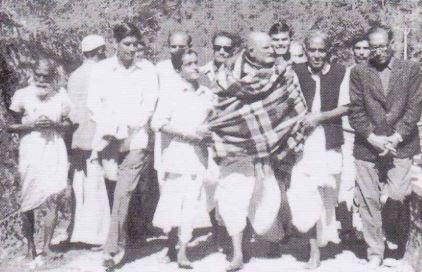
In Dada Mukerjee’s book ‘The Near and the Dear’ there is a story about Maharaji taking on the form and becoming Hanuman.
“In 1961, Babaji was here for his winter camp, and there were many devotees who had come to stay with him. One night it was past eleven and Babaji was in his room with doors closed from inside. All those staying in the house had finished their meals and taken to their beds. Didi and I were busy finishing some work of the household before we could retire. Then I heard the sound of the door to Babaji’s room opening. Kishan was busy opening the door to go out- side, and Babaji was standing beside him. Hearing my footsteps, he turned toward me and seeing me staring at him with full attention, asked Kya? Kya? (What? What?) But without replying, I went to bring Didi to see this for herself. Babaji was standing there, but we had the experience of seeing Hanumanji, who was showing himself through Baba. Babaji had no blanket. His dhoti was drawn tight to the waist, serving as a langoti and the tail end of the dhoti had been twisted and was hanging like a long tail. Taller than he actually was, he had to bend his head to go through the door. His arms were excessively long, reaching below the knees, and there was no bulging belly or white mustache or beard. The belly had sunk to a normal size, and the beard and mustache had turned black. He waited until we reached there, perhaps to give darshan to Didi also, and then he went out with Kishan holding his hand. We stood at our place watching. It was not even two minutes later that they returned. The way in which the whole thing happened left no doubt in my mind that the aim was to demonstrate that Hanumanji was with him and that Hanumanji and he were not different. Many of his devotees believed that he was an incarnation of Hanumanji; actually, Hanuman himself. I had heard them talking thus with all attention, but it was too much for me to believe them at that stage. Babaji returned to his room, as his work, whatever that might have been, was done. But for us it was otherwise. This was just the beginning.”
The Near and the Dear – Dada Mukerjee
The Hanuman Murti, which now sits in the temple in Taos, New Mexico weighs 1,647 pounds and looks light and beautiful as he is flying through the air on assignment from Ram to reassure Sita, who is in captivity, that she has not been forgotten.

Hanuman – Neem Karoli Baba Temple, 2016
The Beginning of the Neem Karoli Baba Ashram
in Taos, New Mexico
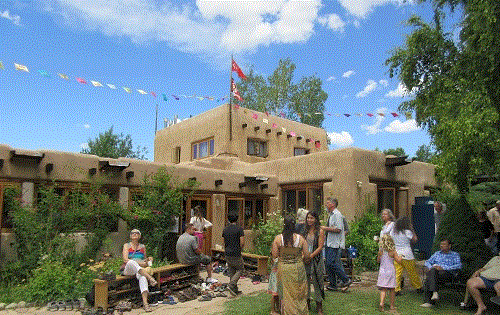
Neem Karoli Baba Ashram, 2016
Maharajji’s devotees were spread all over the country. There was no central meeting place for them to gather and share their love for Maharajji. In India, there are special days when devotees gather to celebrate their love for their Guru, one of them is the day their Guru passes, called Mahasamadhi. Thus, when Hanuman arrived in the U.S. in the summer of 1978, he was put on a trailer and driven to New Mexico. Vishu Magee volunteered to have Hanuman temporarily stay at his home in Arroyo Seco, north of Taos.
With Hanuman resting in Arroyo Seco, the devotees had a place to celebrate of their Guru’s Mahasamadhi. In September of 1978, on the property of Vishu and Kaushulya Magee (Karen Pettit) the murti of Hanuman was partially uncrated and the first Celebration in America of Neem Karoli Baba’s Mahasamadhi was held.

During this time Bandara moved to various locations in the Taos area, and Vishu and Kaushulya Magee purchased 19 acres in the town of Taos. It is here in 1982 on what is now the Neem Karoli Baba Ashram Hanuman was given a permanent home.
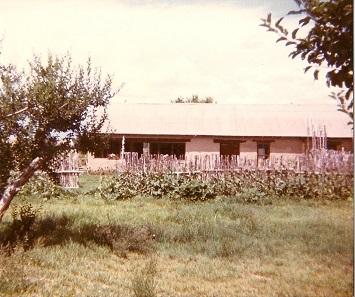
Milk barn where Hanuman was placed
The new devotee’s now had a place to gather, worship and celebrate their Guru. The highlight of their devotion occurred during a September celebration of Maharajji’s Mahasamadhi, known as a Bandara.
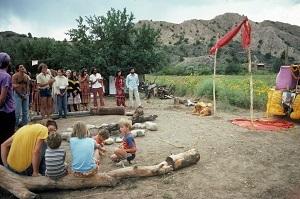
Embudo, 1979
Taos now became a center for Maharaji’s devotees and more and moved devotees began to settle in the area where a true Maharajji Satsang form. It was estimated the early celebrations accommodated over 400 people making Taos and the Neem Karoli Baba Temple one of the largest annual festivals of eastern religious flavor to come out of the ‘cultural revolution of the 60’s’.

Expanding the temple, 1982
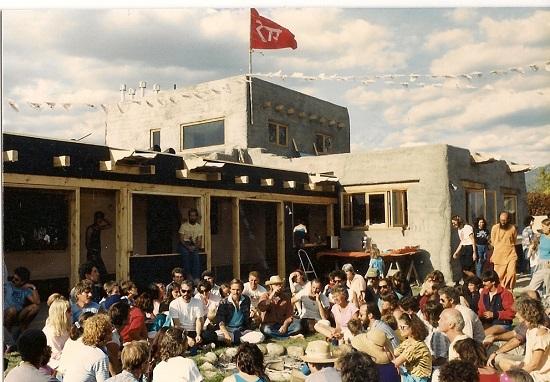
1985 Temple Gathering
In 1973 Vishu Magee settled in Taos with his then wife Kausalya (Karen). It was on their property that the Ashram was built. Read his story of the early history of the Neem Karoli Baba Ashram and Hanuman Temple,
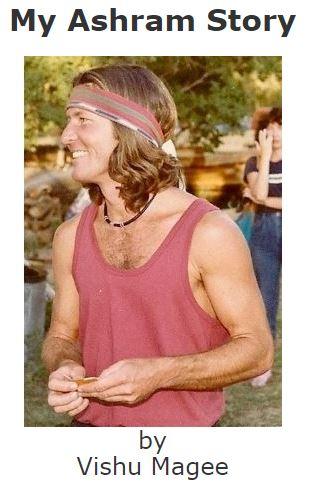
![]() was asked to write my story of the founding and early years of the ashram.Here it is: no doubt it will run counter to the consensus view, and it may offend many of the faithful. I have no wish to be critical of either the ashram or its adherents. But critical thinking, so often missing in matters of religious belief, is always a good thing. I commend the ashram if indeed it is willing to publish this countervailing account. More...
was asked to write my story of the founding and early years of the ashram.Here it is: no doubt it will run counter to the consensus view, and it may offend many of the faithful. I have no wish to be critical of either the ashram or its adherents. But critical thinking, so often missing in matters of religious belief, is always a good thing. I commend the ashram if indeed it is willing to publish this countervailing account. More...
The following is from Hanuman’s Tale, The Messages of a Divine Monkey – Philip Lutgendorf
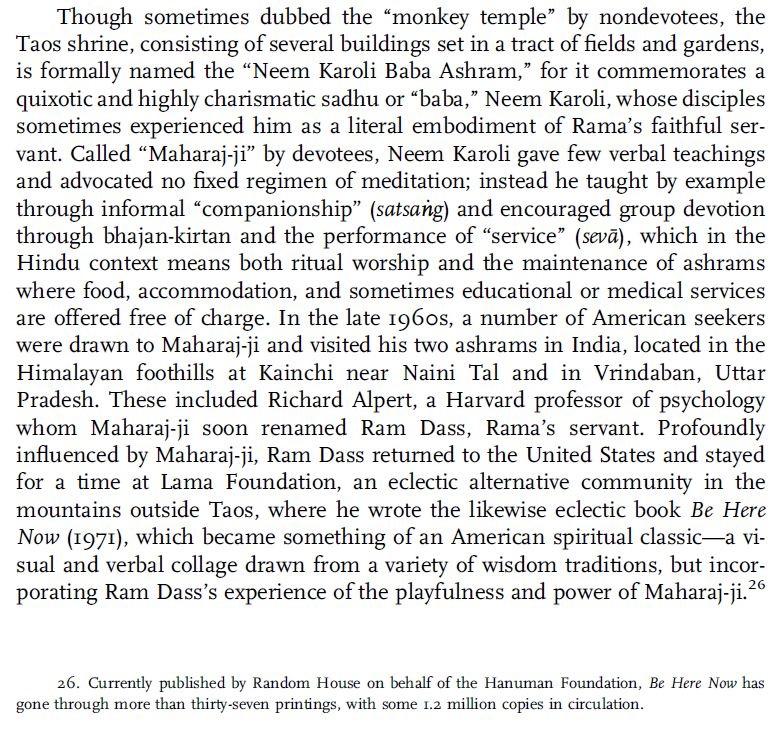

The Last Days of Neem Karoli Maharaj-ji

© 1973 – 2050 Janaki Rathod Permission to sell this in any form is denied. Permission to publish or reprint this is only by arrangement with Janaki Rathod
 n Saturday afternoon, September 98, 1973 Maharaj-ji listened to devotional songs being sung by his western Satsang sitting outside of his office. He then looked up and said, “Neem Karoli Baba Margaya! Uppar Gaya.” “Neem Karoli Baba is Dead! He’s gone up there.” He pointed heaven-ward.
n Saturday afternoon, September 98, 1973 Maharaj-ji listened to devotional songs being sung by his western Satsang sitting outside of his office. He then looked up and said, “Neem Karoli Baba Margaya! Uppar Gaya.” “Neem Karoli Baba is Dead! He’s gone up there.” He pointed heaven-ward.
A man then came with a request to speak privately with Babaji. Maharaj-ji indicated that there was no time at present. The man suggested the next morning. Maharaj-ji said, “If I’m still alive in the afternoon.” He asked Rekha, Dwarka Shah’s wife, if a saint died, would her husband visit his samadhi. She replied that he would if Maharaj-ji ordered him to.
At 5:00 PM. Maharaj-ji insisted that Dr. Larry visit Kabir’s house. During this time a local doctor came and examined Maharaj-ji and gave him nitroglycerin for his heart.
On Sunday, Maharaj-ji came out around 8:00 AM, as usual, he gave darshan outside for most of the morning, until 11:00 AM or so. Mr. Kishan Dhar (KC) Tewari was there and Maharaj-ji said “Dhyan Karo,” (meditate) and Tewari entered samadhi. Maharaj-ji had various people try and bring him out of samadhi but nothing worked. Tewari was carried into the office.
Maharaj-ji told a few people that he would be going to move about four, four, or five days. Kiloney Walla came and pranamed and sang a song to Maharaj-ji. Maharaj-ji said, “he wants to leave his body. But if he left now, he’d just come back within a second.” He then spoke about the Vrindaban Ashram and told the Ram’s to see Dr. Mathur heart specialist in Agra.
He crossed over to the office and everyone went in. People were told to check Tewari and Maharaj-ji asked them, “Kya hua?” (what happened?) He said, “they check everything.” Maharaj-ji then said about Tewari, “he will stay and I will go.” He sent everyone out and woke Tewari up. He told Tewari, “They’re yours now, you look after them.” Tewari said he couldn’t do it. Maharaj-ji then said, “I will give you the power.”
Maharaj-ji then went and sat outside and asked the Satsang to sing. There were many Indian devotees there that day. He wanted them to sing, “Hanuman Chalisa”, “Sankata Mochana”, “Guru Pranam”. Maharaj-ji had tears in his eyes as they sang ad then he said, “sing, OM Jai Jagadish Hare”.
The Nanital Ma’s appeared with an Arti and sandal-paste. Maharaj-ji allowed everyone to tilak him and wave the lights. He didn’t wipe off the Tilak. (Usually he did so immediately.)
Maharaj-ji then got up to go in for his bath. On the way, people noticed Tewari leaning against the pillar, listening still to Janaki singing “Mere Gurudev,” he was tapped and almost fell over. Maharaj-ji had him sit down and told his devotees to leave him there. After some joking and playing Tewari was placed close to Maharaj-ji. Who covered him with his blanket. Then he slapped him a few times on the head and yelled his name and said, “get up.”
Maharaj-ji went in for a bath and meal. He took no rest after a meal and talked on and on to Tewari and the mothers. He thanked the mothers for serving him for so long.
At about 2:30 PM. He walked out of his room, said to stop the puris now and take all the mothers to Nanital. With a few people accompanying him, Maharaj-ji went to see Hanumanji. He stood there for a few minutes and then pranamed Lakshmi-Narayan and the Shiv-ling.
Maharaj then started to leave the ashram. He went across the bridge. And into Indra’s waiting car. He didn’t talk to or notice anyone, except as in the note below. Then he slammed the door on a little girl’s finger and without taking notice of this, drove off with Indra and Ravi.
Janaki’s note: On the last day at Kanchi while Maharaj-ji was having his lunch with Kishan Dhar Tiwari in his room, I was sitting outside Maharaj-ji’s bedroom window in Kainchi – I was alone on the Devi Mandir Parikrama. Maharaj-ji was directing me to sing various songs through the window. He particularly wanted the Sri Ram Stuti and had me repeat it. At about 2:30 he came out the doors to the veranda and burst through them with a loud whack as he pushed them aside and they hit the veranda wall. I ran to grab his hand to go down the steps to the courtyard. There was no one around. He paused at the top of the steps and pointed to the storeroom above his office and said loudly that there was not enough atta or ghee and that no one knows how to make the proper arrangements and that the stores would run out. He was most annoyed about this. He dragged me down the steps and over to the Devi Mandir where he approached, leaned on the railing and placed his two hands together in a namascar gesture. Then, he again grabbed my hand and we went to Hanuman-ji where he did the same. At this time Dwarka Shah and Ravi Khanna joined us and, after Maharaj-ji had paid respects to all the murtis, including the Devi in the kirtan hall, we proceeded across the bridge. Maharaj-ji turned back midway, saw me, now behind him, and glared fiercely into my eyes, so scary! He then said, “Central Jail chorunga.” (Central Jail, will leave). Inder was hurrying down the steps from the gate to the bridge. Maharaj-ji took a few swift steps forward and his blanket fell off his shoulder. Ravi caught it and put it up again.
On the road the next morning, he wrote his Ram-diary. As usual. He did Sundays did Mondays and dated it. Then dated the page for Thursday, Tuesday approaching the planes. They noticed a rainbow reaching from the river back into the river. Maharaj said “Only God can make such beautiful things. Man cannot make such things.”
Reaching the station 5 tickets were purchased to Agra. Indra returned to Kainchi. Ravi offered Maharaj-ji the milk put hot into thermos by the mothers. Maharaj-ji said he’d drink it later. Later when he asked for it, it had turned bad. Maharaj-ji told Ravi to throw it out of the window. He said to throw out the Thermos too, and not to have attachments for anything.
Once on the train Maharaj-ji told Ravi to sleep on the bunk above him. Ravi said he couldn’t do that. And stayed on the floor.
Maharaj-ji kept him up all night and didn’t sleep. He said, “talk with me. I’m not tired.” Maharaj spoke to Ravi about many people, and other sadhus, and many things. When beggars came to the window, Babaji gave them, “Jao”.
After an all-night journey during which Babaji never slept. They pulled into Agra station. Babaji stepped down from the train. And instead of crossing the bridge to the exit, he crossed many sets of tracks. And with one step climbed onto the main platform with Ravi trailing with the luggage, Maharaj-ji was caught at the gate by the ticket examiner. Ravi caught up, presented the tickets and they left the station for the rickshaw stand. Ravi went up to one rickshaw walla and asked the price to civil lines, told 3 rupees. Maharaj-ji rebuked him and asked a second walla who told Maharaj-ji, “2 ½ rupees”, Maharaj-ji said, that’s the right price.
Maharaj-ji sat in the rickshaw. Ravi thought 2 rickshaws would be required. But Maharaj-ji said to sit down and squeeze onto one side. Ravi sat down beside Maharaj-ji and they started off while Maharaj-ji gave giving directions.
After a short while, Maharaj-ji pointed to a house and said in that house, the family feels much sadness because the son has gone to America and left them. He then said, “Sons don’t serve their fathers anymore. Isn’t that right?” Ravi agreed. After a while, Maharaj-ji again pointed to a house. This time, a big fancy house and said, and there lives an oil walla. he’s very rich and very, devoted to God. They continued to drive on all the while Maharaj-ji gave directions to the driver as to which roads and then which house to stop at.
Babaji told Ravi to give the bucket of Maharaj-ji’s Ganga water for drinking to the rickshaw walla. He said, “Give it, have no attachment for anything arriving”.
At the house of Mr. Sharma, an Agra city engineer, Maharaj-ji sent Ravi up to the door to wake them up. Ravi rang the bell of Sharma’s house. Sharma came out and unlocked the door and pranamed. While tying his dhoti. Maharaj went into the house, sat on their bed, and began his stay in the house. His longest stay while lasting until 9:00 PM.
He asked about their children, their family, et cetera, and gave instructions for his lunch, and had them telephone various people and informed them of his arrival. This went on all day long. He was in the best of moods, laughing and telling stories at 11:00 AM. He asked Ravi for the time. He said, “why isn’t it 12 o’clock” after 10 minutes again, “Why isn’t it 12 yet, when will it be 12?”, laughing all the while. Maharaj told the family to prepare his meal for 12 o’clock. Maharaj-ji had been taking no grains for three or four days. So he asked that they prepare only vegetables for him. Ravi refilled the bowl five or six times.
At one time, he sent everyone except Ravi from the room and sang Sanskrit versus to him. Ravi didn’t understand them and asked Maharaj-ji to repeat them. Maharaj-ji just laughed. Ravi thought they were verses to the Mother.
Maharaj left the house only once for less than one hour to visit the heart specialist with his son Dharma Narayan. The Dr. was the head of the medical college and performed an E K G on Maharaj-ji. The doctor found Maharaj-ji’s heart to be healthy. The doctor told Maharaj-ji that his heart was fine and he should only take rest. Maharaj-ji just laughed.
In the evening Maharaj-ji said he would take his meal on the train. At 9:00 p.m. Maharaj-ji, Ravi, and Dharma Narayan went to the station, and tickets were purchased for Kathgodam. We were in the first-class cabin section. Maharaj ate his meal sometime after the train started. Maharaj-ji then asked Ravi to sit in the next cabin for a while. Ravi went next door and the occupants of the other cabin took him to be a thief who had somehow stolen a ticket. They pulled the emergency chain and the train stopped. The train police came and questioned Ravi about the disturbance. Ravi refused to disturb Maharaj-ji to get an explanation. The Police then pushed Ravi around some and took him off the couch and into the police compartment where he was questioned more. Finally, by the next station, the police agreed to ask Maharaj-ji about Ravi. Maharaj-ji said, “bring him, bring him.” Maharaj-ji then noticed they had beaten Ravi. He said, “they’ve beat my son. they shouldn’t have beat my son.” Ravi was in tears at Maharaj-ji’s loving reactions. Maharaj-ji then said that they wouldn’t go to Kainchi just now they would get off at Mathura and then go to Vrindaban. At Mathura, Maharaj-ji would call the local superior police officer and have these men reprimanded for such actions.
At about 11:30pm or midnight the train pulled into Mathura station and the three disembarked (Dharam Narayan, Ravi and Maharaj-ji), several people in the station recognized Maharaj-ji and they pranam to him. They walked to the the station entrance. Maharaj-ji sat down on the steps and sent Dharma Narayan to arrange for a taxi to Vrindaban. While Dharma Narayan was gone Maharaj laid down on the steps and closed his eyes and his body began to tremble. Ravi looked at him. Maharaj-ji opened his eyes full at Ravi, but appeared not to recognize him or anyone. Sometimes his eyes were closed other times open partially, but just staring. He said he was hot and they should fan him. Ravi felt him. His whole body was very wet and his skin was ice cold.
Maharaj-ji then asked for water and some was poured into his mouth. He said, “turn off the lights, it’s too bright.” Ravi said, “Maharaj, we’re in the train station we can’t turn the lights off.” Instead, we held up his blanket and shaded his eyes. He then gave instructions to be taken to a doctor or to a hospital.
Ravi and Dharma Narayan then put him onto a station stretcher and laid him onto the back seat of the taxi. They drove the six miles to the Vrindaban with Ravi in the front and Dharma Narayan fanning Maharaj-ji from between the seats. Maharaj sometimes opened his eyes halfway and mumbled inaudibly. For the most part, his eyes were closed and he appeared unconscious. Upon reaching the Ramakrishna Hospital in Vrindaban. Maharaj-ji was carried inside where attendance gave him two injections and had an oxygen mask placed over his nose and a blood pressure gauge wrapped around his arm. Maharaj-ji twice took the oxygen mask off and said, “this is useless.” His arms were held down and then asked for water. He then said, “Ram, Ram Jagdish hare, Jagdish Hare, Jagdish, Hare” and then closed his eyes. He closed his two eyes for the final time at about 1:00 AM. A doctor then came in, felt his pulse and respiration. The doctor said he was dead and walked back out, leaving Maharaj-ji, Dharma Narayan and Ravi alone. Ravi and Dharma Narayan carried him back out and placed his body in the taxi. They drove to the Hanuman temple and carried his body inside. Once it was placed on his bed. Ravi went to notify local devotees and to telephone and Telegraph distant ones.
© 1973 – 2050 Janaki Rathod Permission to sell this in any form is denied. Permission to publish or reprint this is only by arrangement with Janaki Rathod

My history includes growing up in Berkeley, California, the eldest daughter of an architect and a teacher. I became a vocal student of Ustad Ali Akbar Khan in Berkeley in 1967 and started to learn Hindi at that time. Later, I lived in India for about 8 years, where I studied Indian Classical vocal music at the Bhatkhande College of Music in its Nainital branch. At this college all instruction was in Hindi. During this time I spent a great deal of time with Neem Karoli Maharaji and often sat with him in both Kainchi and Vrindavan. After his passing, I continued to visit India throughout my life and married into an Indian film family based in Bhandra, Mumbai, as the eldest son’s wife. I also majored in Asian Languages in University and to this day I enjoy watching Bollywood films! Read more >>>
—-
Until then….
Enjoy Guru Purnima
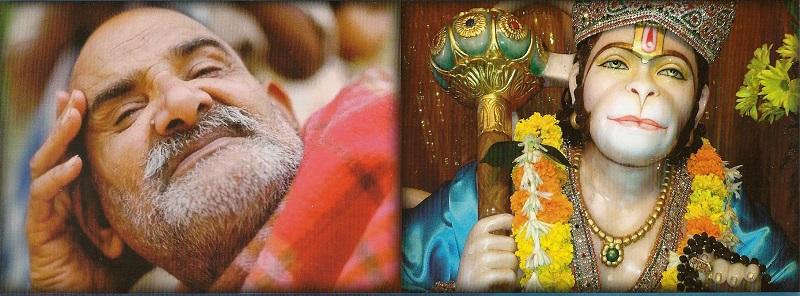

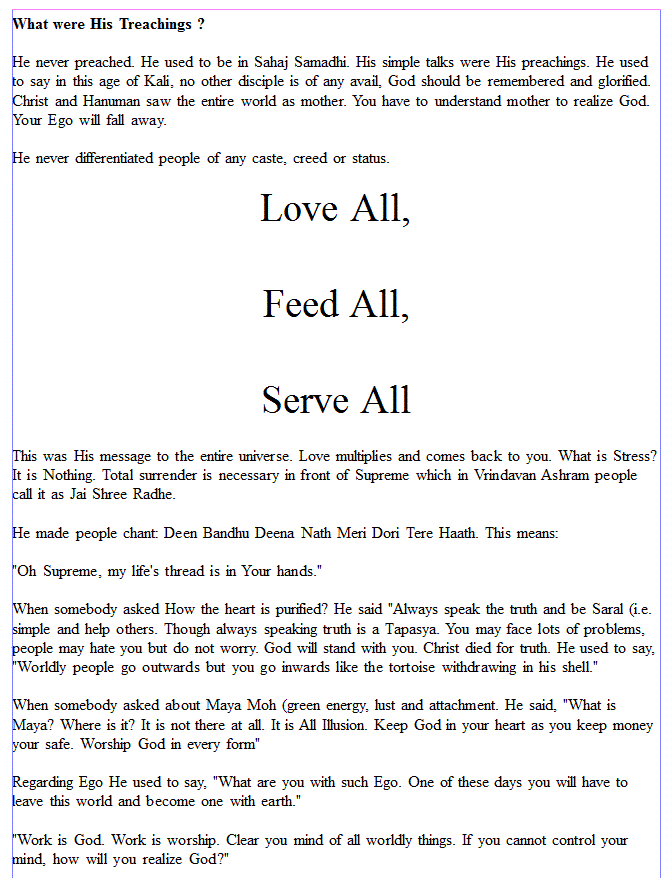
Additional Sources
The Making of ‘Be Here Now’
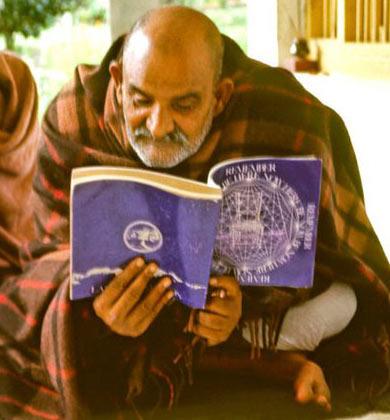
“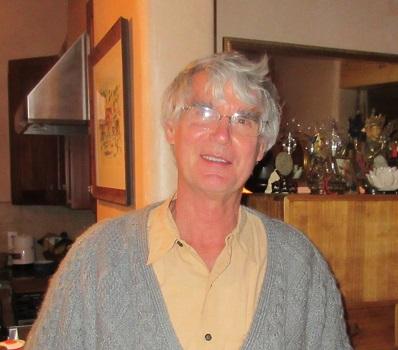
by Dwarka Bonner
Listen
